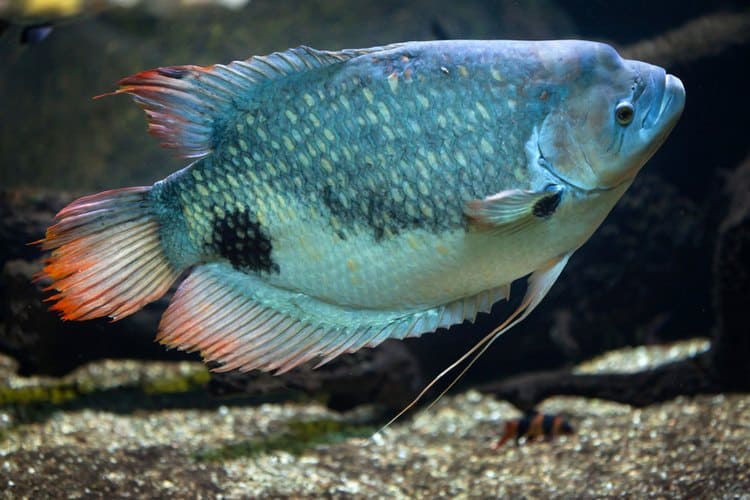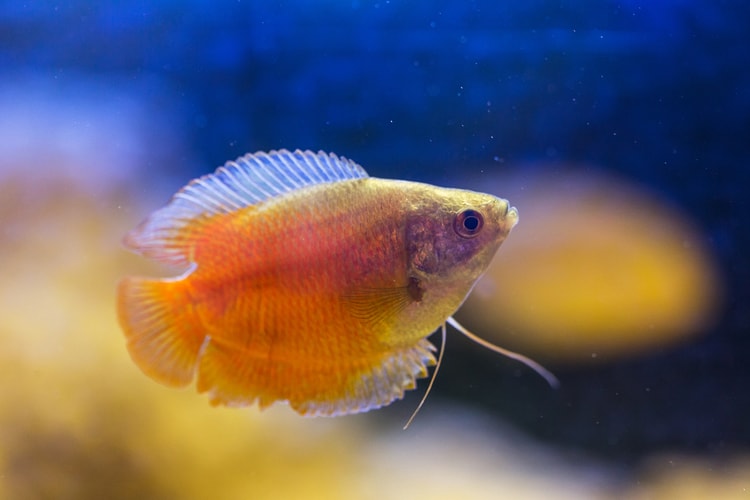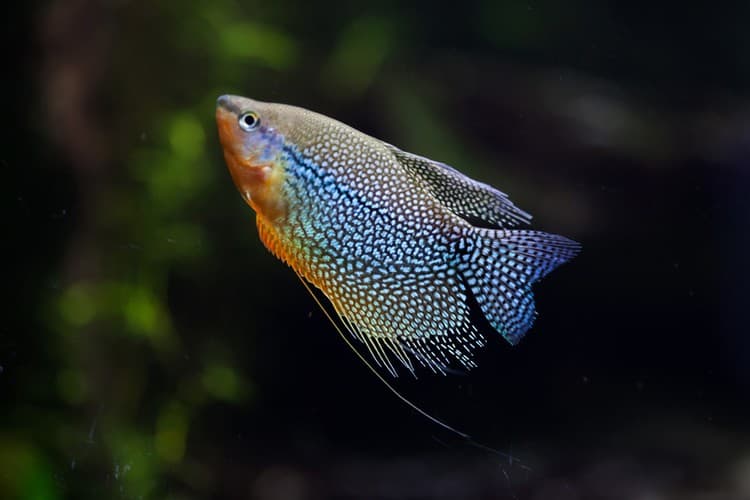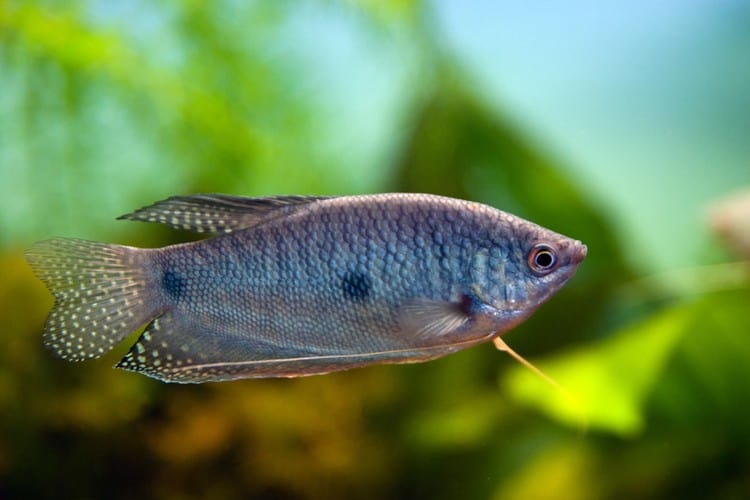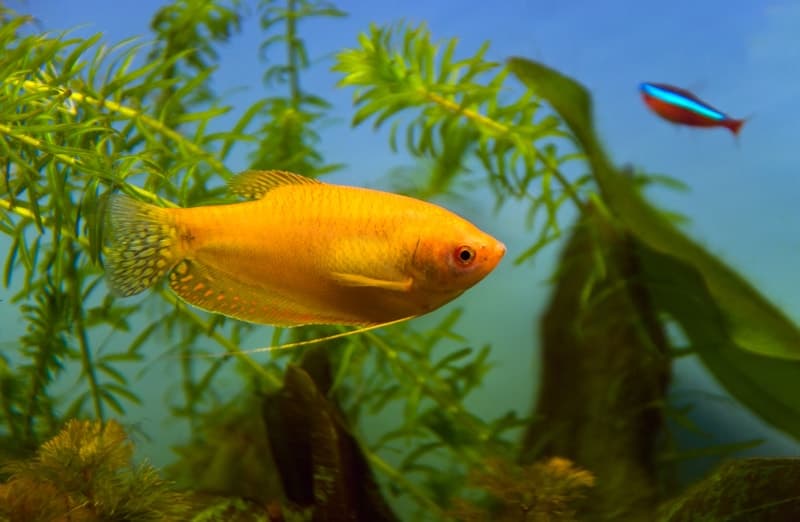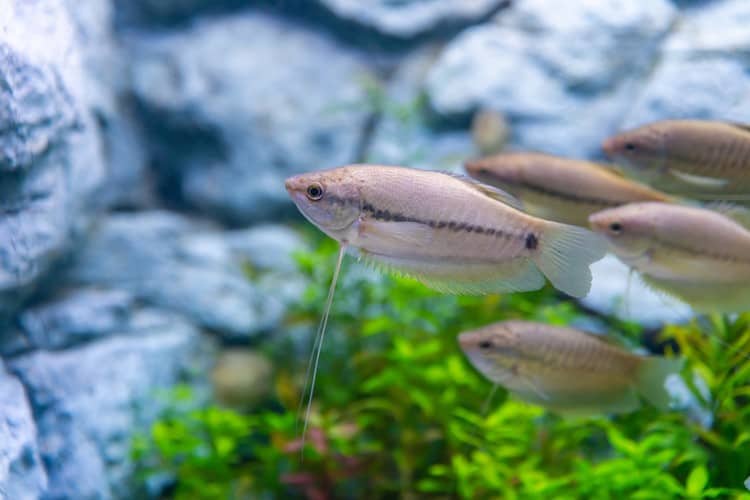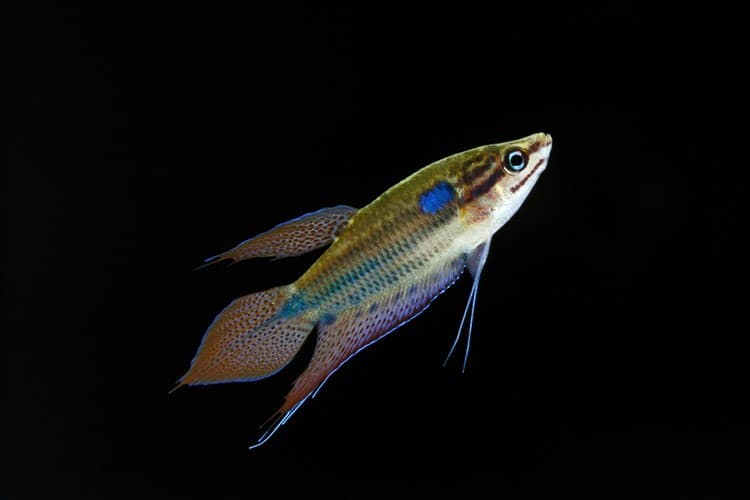Gourami is a popular kind of fish, particularly amongst aquarists. Gouramis are a type of freshwater fish from the families Osphronemidae Helostomatidae and Anabantidae. There are different types of gourami fish, and they are popularly liked amongst aquarists.
They come in several colors and sizes but in somewhat similar body shapes. If you are considering keeping gouramis, then you need to understand some details about their natures to know how to successfully keep them.
Many aquarists, both beginners and seasoned fish experts, have found gourami fish to be a nice species of aquatic organisms that can be kept successfully.
There are however many variants of the gourami, such that people get confused as to which is which. Here are some very popular types of gourami fish.
- The Dwarf Gourami
- The Sunset Gourami
- The Pearl Gourami
- The Giant Gourami
- The Blue Gourami
- Chocolate Gourami
- Honey Gourami
- Snakeskin Gourami
- Sparkling Gourami
- Kissing Gourami
Dwarf Gourami
This is one popular type of the gourami fish. It is known to be naturally small and peaceful. It is equally known as flame gourami because it usually has a bright red colour from its middle part. However there are different colours from hybrids.
It is also regarded as a labyrinth fish, that is, it takes in oxygen by breathing in air with a special organ. This requires it to have access to the surface of the water. Even at its adult state, it does not grow beyond about 2 inches.
Like many aquarium fish, it does not usually live for more than four years at the most. The Dwarf gourami is relatively easy to take care of. They are quite unaggressive and do not cause harm to other fishes in their tank.
However, they should not be kept with very large or aggressive fish. Although they are quite active and would usually swim around the aquarium at all levels. They can however be shy also, if they find themselves in unfamiliar territory.
Sunset Gourami
The Sunset Gourami is another popular type which is favoured by new aquarists and seasoned ones alike. They are well preferred due to their orange/golden colour which earned it the name. The colour is quite distinct amongst fishes, which makes it a well-liked breed.
They are easy to take care of also and quite shy among their tank mates. Thus they like to hide amongst the plants which are required to be in abundance in their aquarium. They need good water conditions and a stable, safe environment in order to thrive.
Pearl Gourami
This gourami type is popular for its hardiness. It can practically share a tank with any species of fish. It also has a relatively long lifespan. Compared to many other aquarium fishes, the pearl gourami lives for as long as eight years, which is pretty long for fishes.
They are also preferred due to their adaptability and non-aggressive nature. They come in a fine pearly colored spot and usually thrive in a well-vegetated aquarium with large amounts of water. At least 6 pearl gourami can be kept in a 30-gallon aquarium.
The aquarium should bear some semblance to a natural habitat for the pearl gourami to thrive. Since they are omnivores, their diet should not be a thing of worry as they would eat pretty much any food you give them.
Giant Gourami
Many gourami fish are usually small in size, but the giant gourami is an exception. They grow to a length of up to 28 inches! Not only this, they also live for a very long time, up to twenty years if properly taken care of. Also, they can be quite aggressive to smaller fish.
They love to swim around a dark tank and preferably stay at the bottom. When they are young and a bit smaller, they are easy to take care of. At about three months old, they usually grow a sort of conspicuously long mouth.
However when they are fully grown they might require expertise in keeping them successfully. Many new or amateur aquarists usually avoid keeping them because of the amount of space they occupy and the challenges in keeping them. They require about 300 gallons of water so that they can have ample swimming space.
hen they usually look a bit fearsome and might harm smaller fishes in their tank. It is important to know that they grow pretty quickly and they attain their large size within a few years. As long as they are kept in a large aquarium and given good food in abundance, you can be sure of having yourself a truly enormous giant gourami in a short while.
Not all type of fish would be ideal tank mates for the giant gourami, because they could have a tendency to bully smaller fishes. They would require fairly competitive tank mates such as knifefish and the large catfish to share a large aquarium with.
Blue Gourami
This type of gourami is also popularly known as “Three Spot Gourami”. They are one of the most common in the several variants of gouramis. They are somewhat similar in their features to some other types of gourami fish, but are usually a transparent sort of blue color.
Being equally small in size, they exist in peace with other fishes, particularly those of equally small size. However, interestingly they do not get along so well with their own kind. In fact, male blue gouramis are usually quite intolerant and are usually kept alone in one tank, although a few females can be kept with them.
Note that when in their natural habitat, the blue gourami grows a bit larger than they do in an aquarium. Thus, they usually require a large tank size. Different hybrids in various patterns exist.
Although they usually grow to just about four inches, they usually require a good amount of water. Thus while they might be fun to keep, many beginners might consider them a bit difficult to handle sometimes.
Chocolate Gourami
This type of gourami fish is popularly known for its delicate nature. It is a peaceful slow moving type of gourami that requires more attention than the average gourami. This is because it is sensitive to harsh or sudden changes in the water, even a slight one.
It is necessary that you keep chocolate gourami in a relatively peaceful environment, with carefully regulated water. Naturally, in the wild, the type of water condition where chocolate gouramis live is usually about 4.0 pH value which is quite low. Thus they require a well-conditioned tank to survive. The tank conditions should permit hiding places because they are quite shy.
Honey Gourami
This gourami type is another fascinating one notable for its similarity with the dwarf gourami. They have similar features but are different types of fish. The honey gourami has thinner and smaller dorsal and anal fins. If you are a beginner, you would most likely fancy having the honey gourami.
One particularly popular feature of this kind is seen in its feeding pattern, in which it catches its prey by tricking them with a sudden squirt of water before eating them quickly. Like many other gourami types, the honey gourami is hardy and can survive in water that’s not so oxygenated.
Also, it also shows a sharp colour difference in the males and the females, the males having a more attractive honey shade compared to the slightly grey female. This is partly because of its labyrinth organ, and also because it is a very resilient fish by nature.
Spanning about 3 inches in length, the honey gourami is similar in size to many others making it a suitable community fish for your aquarium. When properly cared for, they can live up to 8 years. The honey gourami likewise differs from the sunset gourami, or any other similar looking fish.
Snakeskin Gourami
Just as the name implies, the snakeskin gourami fish has an elongated, snake-like shape. It naturally lives in swampy waters with sparse vegetation. It also typically stays close to the surface and prefers slow-moving waters. Many people recognize it as a food fish, but it, however, serves as an aquarium fish well too.
Being a bit longer in appearance, it ranges between 6 to 8 inches long, which is a bit longer than the aveage gourami. They are also quite peaceful and can live with other peaceful species in a community tank. With proper care, the snakeskin gourami can live for about 4 years.
Like many other gouramis, it is a hardy omnivorous fish, which is easy to keep and would feed on practically anything good enough, such as animal matter or flake food.
They eat a lot of food, and so would often require that you feed them properly at all times. In addition, you shouldn’t compare them with snakes based on their name, because it is a name merely based on appearance. The snakeskin fish are absolutely NOT poisonous like snakes, in case you are wondering.
Sparkling Gourami
This is another popular type of gourami. Although it gets avoided by many aquarists because it is very small and timid and has a tendency to be bullied by other bigger fishes, you can still keep it successfully.
It is equally known as pygmy gourami because of its small size. It is however very resilient despite its size and can survive in difficult water conditions. It is equally a really beautiful specie and is marked with blue and red edges with a sparkling red pattern, earning it the name.
Because of its labyrinth organ also, it might often swim close to the surface and eat insects that are on the water surface. However, due to the timid nature, it is quite easy to keep amongst other peaceful fish types.
It also loves dark corners and would shy away from light or being in the open. Although it is not a schooling fish, it still requires the presence of other similar sized fish. Avoid keeping them alone, because they require some bit of interaction just like any other fish.
Kissing Gourami
This gourami type is particularly popular because of its interesting name. It earned this name due to a funny kissing display it shows. It is another large gourami that grows up to a length of 12 inches, with a life span of up to 25 years!
The kissing gourami has been known to display some traits of aggressiveness towards other smaller sized fish. They might not be suitable tank mates for the average gourami because of their size and bully nature.
They need to be kept among equally competitive tank mates such as the large catfish. If you want to have some excitement in your aquarium however, you can opt for the kissing gourami to do just that. It might also require the skills of a seasoned aquarist in its successful keeping.
Some Facts & FAQ’s about Gourami
Are Gourami aggressive fish?
Many people often ask if gouramis are aggressive. Indeed this is a valid question, in order to know what sort of fish community they can be kept in. Some species of gouramis show a bit more aggression than others. Some are even regarded as being peaceful.
But the fact is that all types of gouramis can actually show some aggression. It all depends on the kind of environment they find themselves.
Many can co-habit with other fish successfully but it is necessary that they are monitored and kept with similar sized fish. That is why it is usually advised that they stay in a large fish tank where they can claim some but of individual territory.
Their tank should also be well vegetated so that they can hide and stay less aggressive. The reason why some gouramis could be aggressive might be due to uncomfortable tank conditions, such as cramped space or being amongst too many fishes.
Gouramis get generally irritable when subjected to such conditions. Of all the species of gourami, the blue gourami or three spot gourami is notable for its aggressive nature. The kissing gourami also shows such traits.
Then, the dwarf gourami might lose its peaceful nature if kept in uncomfortable tank conditions. In general, you need to watch carefully in your selection of gouramis, particularly if you’re a beginner, so as not to turn your aquarium into an uncontrollable arena of fighting fishes.
However, this should not dissuade anyone from keeping gouramis. Gouramis are actually known to be good community fish under the right and suitable living conditions.
They do not naturally threaten other peaceful fish in the aquarium. For instance, the dwarf gourami is well known for its non-interfering nature, as it would happily swim without disturbing other fishes.
What kind of fish can live with gourami?
Now that you know that the gourami’s nature can vary from being shy to being aggressive, you might wonder what type of fish can successfully share a tank with gourami.
While it might be exciting it keep gouramis, building a community tank requires that you create a harmonious environment for all the fishes.
Many different species of fish can cohabit with gouramis, but you need to observe that they are equally peaceful and share the same preferences of water.
Gouramis can live successfully with similar sized dishes. This is because they are relatively small themselves and could easily get bullied by bigger fishes. Gouramis could be quite timid and be picked on by aggressive fish.
They should also not be kept with too tiny fishes, which could seem like food to them. Note however that some gouramis themselves can bully their tankmates, such as the Three Spot Gourami and the kissing gourami.
So also, male gouramis should not be kept with other male gouramis because they could act really territorial and fight each other. However, if it is a very large aquarium where each can protect its territory, then you may keep more than one male.
Generally, some fish that you can keep in the same tank with gouramis include other gourami species, bettas, panda corydoras, cyprinids, mollies, plecos, mollies, rainbowfish, dwarf crayfish, rasboras, barbs, Amano shrimp, loaches, ember tetra and many others, depending on the individual nature of the gourami you’re keeping them with.
The important thing is to ensure that their natural needs and preferences are compatible. Gourami fish make good community dishes.
How big do gouramis get?
Many people are familiar with the small-sized gouramis. Well, you might be surprised to know that there is actually the giant gourami, which is a specie known for its really large size. Gouramis can grow to such surprising lengths too.
Although many species of gouramis are usually within 4 inches thereabouts. Each type of gourami grows in varying proportions. For instance, the dwarf gourami grows to about 2 inches. The flame gourami is also about 2 inches in length.
How can you tell if gourami is a male or a female?
If you are a new aquarist, you might get confused when distinguishing between males and female fishes. It is, however, a skill required if you want to keep an aquarium successfully. More so, it gets tricky when trying to do so for different species, such as gouramis, but when you know what to look out for, it’s quite easy.
Gouramis are not always very easy to identify based on sex. Usually, male fish are quite smaller than female fish, and more colorfully patterned than the female fish, and this is particularly true for gouramis. Female gouramis usually come in grey colors with lesser colors.
However, crossbreeds have brought about color variations that make male and females hard to differentiate by color. Female gouramis are usually recognized by their round bellies. If you also look at the dorsal fin in females, you discover it is quite shorter and rounder compared to that of males. The dorsal fin in males is quite long and pointed.
Here are some more care tips for your gourami
Caring for gourami fish also vary from specie to specie. This is why it vital for you to know the different types of gourami fish and their requirements before embarking on breeding any of them.
Firstly, you must understand the basics of caring for the fishes in an aquarium such as making sure they are in suitable water conditions. Changing the water in the tank must be handled cautiously and frequently. Some species require changes more often than others.
The Water Condition is Vital in Gourami Care
Some gouramis actually prefer the water to be somewhat darkened with organic matter, especially at the bottom. However, a clean tank is an indispensable requirement in caring for your gourami. This is very vital in order to avoid diseases from contaminated water.
Because the gourami has the labyrinth organ which helps them to breathe in air from the surface of the water, they are usually sensitive to water changes. While many types prefer warm water, they are generally quite sensitive to temperature and sudden disruption in the water they are used to.
Sudden temperature changes can have a bad effect on their labyrinth organ. Seeing as a number of them are shy, you should be careful about the level of light let into the tank.
You also need to be careful against diseases affecting your gourami. Some common diseases which affect gouramis are preventable when the water is kept clean.
In addition, as earlier shown, ideal tank mates also contribute to the welfare of gouramis. You wouldn’t want to keep gourami with aggressive fishes that would bite or stress out your other gouramis. Also, the more gouramis you have, the more gallons of water you would require.
Many gouramis also dislike fast moving water, so you might need to control the current in the aquarium. So you might need a fairly large tank if you want to successfully maintain a community of gouramis.
Keeping gourami fish is definitely an interesting endeavor. You only need to be thoroughly knowledgeable about their specified nature and requirement, constantly updating yourself on ways to recognize the needs. By successfully keeping gouramis, you get better at being an expert aquarist within a short period of time.

